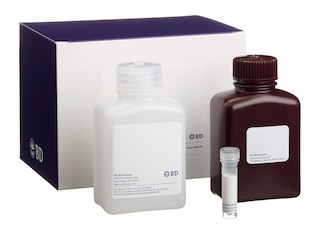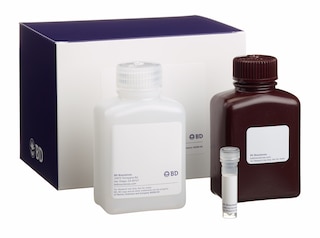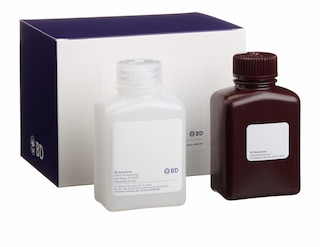-
Your selected country is
Middle East / Africa
- Change country/language
Old Browser
This page has been recently translated and is available in French now.
Looks like you're visiting us from {countryName}.
Would you like to stay on the current country site or be switched to your country?


.png)

Expression of IL-2 by stimulated CD3+ human PBMC. Human PBMC were stimulated for 6 hours with PMA (Sigma) and calcium ionophore A23187 (Sigma) in the presence of GolgiStop™ (2 mM final concentration; Cat. No. 554714). The PBMC were stained with PE-Cy5-anti-CD3 (PE-CY5 UCHT1, Cat. No 555334), fixed, permeabilized, and subsequently stained with 0.25 mg of FITC-Rat IgG2a, κ anti-human IL-2 antibody (FITC-MQ1-17H12, Cat. No 554565; left panel) or 0.25 mg FITC-R35-95 isotype control immunoglobulin (FITC-R35-95, Cat. No. 554688; right panel) using Pharmingen's staining protocol. To demonstrate specificity of staining, the binding of FITC-MQ1-17H12 was blocked by the preincubation of the conjugated antibody with molar excess of recombinant human IL-2 (Cat. No.554603; data not shown), and by preincubation of the fixed/permeabilized cells with an excess of the unlabelled MQ1-17H12 antibody (Cat. No. 554563; data not shown) prior to staining with the FITC-MQ1-17H12 antibody. The quadrant markers for the bivariate dot plots were set based on the autofluorescence control, and verified with the recombinant cytokine blocking and unlabelled antibody blocking specificity controls.
.png)

BD Pharmingen™ FITC Rat IgG2a, κ Isotype Control
.png)
Regulatory Status Legend
Any use of products other than the permitted use without the express written authorization of Becton, Dickinson and Company is strictly prohibited.
Preparation And Storage
Recommended Assay Procedures
Immunofluroescent Staining and Flow Cytometric Analysis: The FITC-R35-95 immunoglobulin (Cat. 554688) is a suitable rat IgG2a κ isotype control for assessing the level of background staining on paraformaldehyde-fixed/saponin-permeabilized mouse or human cells for flow cytometric analysis. Use at comparable concentrations to antibody of interest (e.g., 0.5 mg mAb/1 million cells). See image, right panel. For specific methodology, please visit our web site, www.bdbiosciences.com, and go to the protocols section or the chapter on intracellular staining in the Immune Function Handbook. The intracellular cytokine staining technique and use of blocking controls are described in detail by C. Prussin and D. Metcalfe.
Product Notices
- Since applications vary, each investigator should titrate the reagent to obtain optimal results.
- Please refer to www.bdbiosciences.com/us/s/resources for technical protocols.
- Caution: Sodium azide yields highly toxic hydrazoic acid under acidic conditions. Dilute azide compounds in running water before discarding to avoid accumulation of potentially explosive deposits in plumbing.
Companion Products



The R35-95 hybridoma was generated by hybridization of Y3 myeloma cells with spleen cells from LOU rats immunized with mouse immunoglobulins. The R35-95 hybridoma produces rat IgG2a, κ immunoglobulin that has no measurable reactivity with mouse immunoglobulins. The R35-95 immunoglobulin was selected as an isotype control following screening for low background binding on a variety of mouse and human tissues.
This antibody is routinely tested by flow cytometric analysis. Other applications were tested at BD Biosciences Pharmingen during antibody development only or reported in the literature.

Development References (1)
-
Prussin C, Metcalfe DD. Detection of intracytoplasmic cytokine using flow cytometry and directly conjugated anti-cytokine antibodies. J Immunol Methods. 1995; 188(1):117-128. (Methodology). View Reference
Please refer to Support Documents for Quality Certificates
Global - Refer to manufacturer's instructions for use and related User Manuals and Technical data sheets before using this products as described
Comparisons, where applicable, are made against older BD Technology, manual methods or are general performance claims. Comparisons are not made against non-BD technologies, unless otherwise noted.
For Research Use Only. Not for use in diagnostic or therapeutic procedures.
Report a Site Issue
This form is intended to help us improve our website experience. For other support, please visit our Contact Us page.